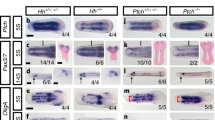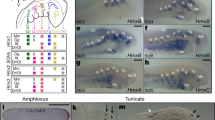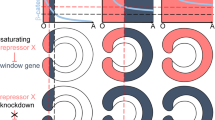Abstract
According to the dorsoventral axis-inversion theory1, protostomes (such as insects, snails and worms) are organized upside-down by comparison with deuterostomes (vertebrates)2,3,4,5, in which case their respective ventrally (belly-side) and dorsally (back-side) located nervous systems, as well as their midline regions, should all be derived from a common ancestor5. Here we provide experimental evidence for such homology by showing that an orthologue of hedgehog, an important gene in midline patterning in vertebrates, is expressed along the belly of the larva of the limpet Patella vulgata. This finding supports the existence of a similar mechanism for the development of the midline of the nervous system in protostomes and deuterostomes.
This is a preview of subscription content, access via your institution
Access options
Subscribe to this journal
Receive 51 print issues and online access
$199.00 per year
only $3.90 per issue
Buy this article
- Purchase on Springer Link
- Instant access to full article PDF
Prices may be subject to local taxes which are calculated during checkout

Similar content being viewed by others
References
Arendt, D. & Nübler-Jung, K. Nature 371, 26 (1994).
Geoffroy St Hilaire, E. Mém. Mus. Hist. Nat. 9, 89–119 (1822).
De Robertis, E. M. & Sasai, Y. Nature 380, 37–40 (1996).
Arendt, D. & Nübler-Jung, K. Mech. Dev. 61, 7–21 (1997).
Arendt, D. & Nübler-Jung, K. Development 126, 2309–2325 (1999).
Sasai, Y. & De Robertis, E. M. Dev. Biol. 182, 5–20 (1997).
Menne, T. V., Luer, K., Technau, G. M. & Klambt, C. Development 124, 4949–4958 (1997).
Lawrence, P. A. & Struhl, G. Cell 85, 951–961 (1996).
von Werner, B. Helgol. Wiss. Meeresunters. 5, 169–217 (1955).
Morril, J. B. in Developmental Biology of Freshwater Invertebrates 399–483 (Liss, New York, 1982).
Kennedy, J. J. & Keegan, B. F. J. Mar. Biol. Assoc. UK 72, 783–805 (1992).
Crowther, R. J. & Whittaker, J. R. J. Neurobiol. 23, 280–292 (1992).
Nielsen, C. Animal Evolution (Oxford Univ. Press, Oxford, 2001).
Author information
Authors and Affiliations
Corresponding author
Ethics declarations
Competing interests
The authors declare no competing financial interests.
Additional information
brief communications is intended to provide a forum for both brief, topical reports of general scientific interest and technical discussion of recently published material of particular interest to non-specialist readers. Priority will be given to contributions that have fewer than 500 words, 10 references and only one figure. Detailed guidelines are available on Nature's website (http://www.nature.com/nature) or on request from nature@nature.com
Rights and permissions
About this article
Cite this article
Nederbragt, A., van Loon, A. & Dictus, W. Hedgehog crosses the snail's midline. Nature 417, 811–812 (2002). https://doi.org/10.1038/417811b
Issue Date:
DOI: https://doi.org/10.1038/417811b
This article is cited by
-
Step-wise evolution of neural patterning by Hedgehog signalling in chordates
Nature Ecology & Evolution (2020)
-
Comparative transcriptomics enlarges the toolkit of known developmental genes in mollusks
BMC Genomics (2016)
-
Nodal signalling is involved in left–right asymmetry in snails
Nature (2009)
-
Marine invertebrates, model organisms, and the modern synthesis: epistemic values, evo-devo, and exclusion
Theory in Biosciences (2009)
-
EvoD/Vo: the origins of BMP signalling in the neuroectoderm
Nature Reviews Genetics (2008)
Comments
By submitting a comment you agree to abide by our Terms and Community Guidelines. If you find something abusive or that does not comply with our terms or guidelines please flag it as inappropriate.



